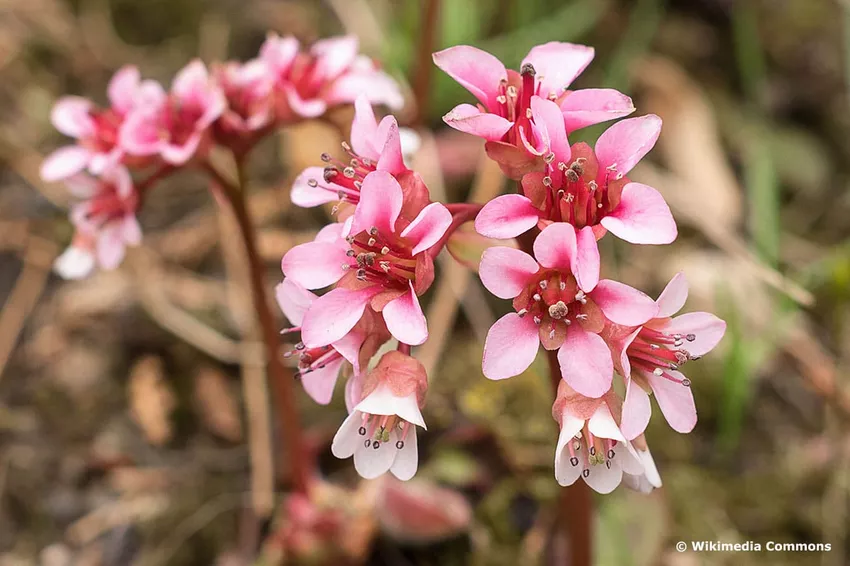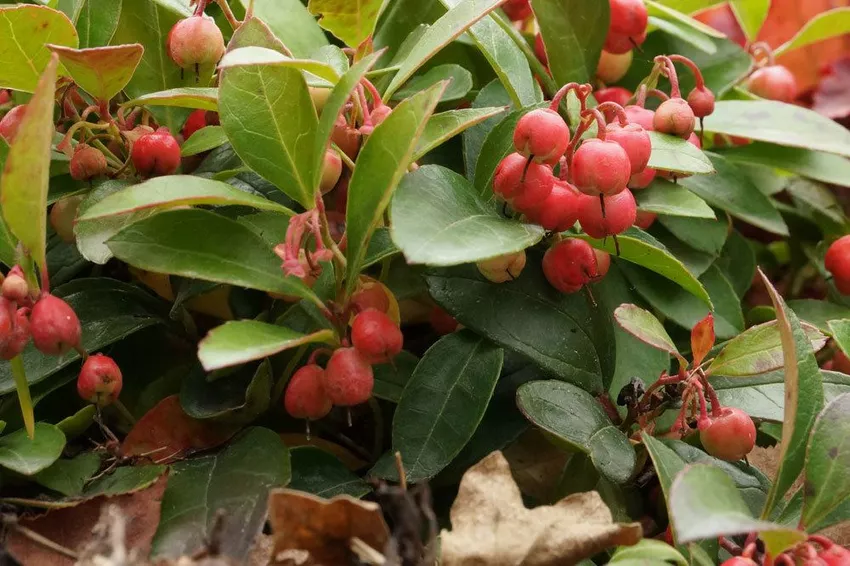
Shady places in the garden are usually a problem because not so many plants grow there. It becomes even more difficult if the soil is acidic at the same time. A selection of suitable ground cover for shady places and acidic soil can be found here.
In a nutshell
- Shade plants grow in dark garden corners
- tolerate light but no direct sun
- the lighter, the more moisture is needed
- Soil can be acidified with bark mulch
Types from A - I
Wood Anemone (Anemone nemorosa)
 Wood anemone, Anemone nemorosa
Wood anemone, Anemone nemorosa
- Origin: local
- Location: shady to shady, loose, humus-rich, well-drained soil
- Growth height: 10 to 20 cm
- pH value: calcareous to slightly acidic soil
- Properties: Slightly toxic, withers leaves after flowering, does not form green ground cover all year round
- Flowers: spring, white-pink
- Care: easy to care for, do not chop, water and mulch if necessary
fat man (Pachysandra terminalis)

- Origin: Japan, China
- Location: partially shaded to shaded, slightly moist soil
- Growth height: 15 to 30 cm
- pH value: neutral to slightly acidic
- Characteristics: evergreen, poisonous, underground runners, shoots become woody in the lower part, the foliage yellows in too much sun
- Flowers: April to May, white, small
- Care: undemanding, only water when dry
ferns
 Source: Daderot, Blechnum penna-marina - Berlin Botanical Garden - IMG 8763, edited from Plantopedia, CC0 1.0
Source: Daderot, Blechnum penna-marina - Berlin Botanical Garden - IMG 8763, edited from Plantopedia, CC0 1.0
- Origin: domestic and worldwide
- Location: shady, sheltered from the wind, moist, permeable and loose soil
- Growth height: 30 to 75 cm
- pH value: alkaline to acidic
- Properties: Leaves form typical fern fronds, curled up when young, no flowers or seeds formed, form spores
- Care: mulch, keep moist, protect from direct sun
- Suitable types and varieties: peacock wheel fern (Adiantum pedatum), oak fern (Gymnocarpium), rib fern (Blechnum), spleen fern (Asplenium), polypody (Polypodium), eyelash fern (Woodsia)
Spring Commemorative (Omphalodes Verna)
 memorial
memorial
- Origin: Southern Europe
- Location: semi-shady to shady, not too dry, well-drained, nutrient-rich soil
- Growth height: 10 to 20 cm
- pH value: neutral to slightly acidic soil
- Properties: forms runners and dense carpets of leaves
- Flowering: April and May, blue, speedwell or forget-me-not like flowers
- Care: easy to care for and robust
Notice: Commemorative plants can easily be divided as ground cover and planted out again in acidic soil.
Types of J - K
Japanese sedge (Carex morrowii)
 Carex morrowii, Japanese sedge
Carex morrowii, Japanese sedge
- Origin: Japan
- Location: partially shaded to shaded, moist, sheltered from the wind, nutrient-rich soil
- Height of growth: 30 to 40 cm
- pH value: neutral to slightly acidic
- Characteristics: host-forming grass, green or green-white striped, evergreen
- Flowers: April or June, forms inconspicuous spikes
- Care: water when dry, fertilize in spring, propagate by division
Cashmere bergenia (Bergenia ciliata)
 Source: Frank Schulenburg, Bergenia ciliata, Alter Botanischer Garten Göttingen, edited by Plantopedia, CC BY-SA 4.0
Source: Frank Schulenburg, Bergenia ciliata, Alter Botanischer Garten Göttingen, edited by Plantopedia, CC BY-SA 4.0
- Origin: East Asia
- Location: shady, moist, cool
- Growth height: 5 to 30 cm
- pH value: alkaline to slightly acidic soil
- Properties: hardy, large leaves, forming rosettes, propagation by division
- Flower: spring, pink, red or purple
- Care: supply with compost in spring, water only when dry
Caucasus forget-me-not (Brunnera macrophylla)

- Origin: Eastern Europe and Western Asia
- Location: semi-shady to shady, well-drained, moist soil
- Growth height: 30 to 50 cm
- pH value: slightly alkaline to slightly acidic
- Properties: small perennial, rhizome-forming, multiplies by self-seeding
- Flowers: April to June, blue
- Care: water when dry, fertilize on poor soil
Crawling Bugle (Ajuga reptans)

- Origin: local
- Location: sunny to shady, well-drained, moist, nutrient-rich soil
- Growth height: 15 to 20 cm
- pH value: neutral to slightly acidic
- Properties: creeping, runner-forming, upright flowering shoots
- Flowering: April to June, blue to purple
- Care: easy to care for, can be fertilized, but is not absolutely necessary
Notice: Creeping bugle is such a robust ground cover in acidic soil that it can be mowed down with a lawn mower.
creeping spindle (Euonymus fortunei)
 Euonymus fortunei 'Emerald Gold'
Euonymus fortunei 'Emerald Gold'
- Origin: China
- Location: semi-shady to shady, nutrient-rich, well-drained soil
- Growth height: 20 cm, can climb up to 5 m
- pH value: alkaline to slightly acidic
- Properties: creeps or climbs, forms adhesive roots, hardy
- Flowers: June and July, white
- Care: Water if the location is too sunny, otherwise easy to care for
Types of L - S
Lily cluster (Liriope muscari)

- Origin: Asia
- Location: partially shaded to shaded, warm, sheltered, slightly moist, nutrient-rich, well-drained, also gritty substrate
- Growth height: 80 to 100 cm
- pH value: slightly acidic soil
- Properties: forms cushions, grows from a tuber, evergreen, frost-resistant, propagates via stolons
- Flowering: August to October, lilac or blue
- Care: water when dry, cut back old foliage in spring
Gaultheria procumbens, Red partridge berry
 Gaultheria procumbens
Gaultheria procumbens
- Origin: North America
- Location: partially shaded to shaded, moist, nutrient-poor soil
- Growth height: 15 to 20 cm
- pH: acidic
- Properties: runner-forming, evergreen, red berries in winter, crushed leaves are fragrant
- Flowering: July and August, pink and white
- Care: fertilize in spring and summer, water when dry, avoid waterlogging, tolerates pruning
Porcelain flowers (Saxifraga x urbium)

- Origin: Southern Europe
- Location: partially shaded to shaded, moist, nutrient-poor, well-drained soil
- Growth height: 10 to 30 cm
- pH value: slightly alkaline to acidic
- Properties: forming rosettes, evergreen, filigree flower panicles
- Flowering: May and June, star-shaped flowers in white, pink and red
- Care: no care required
Cranberry (Vaccinium vitis-idaea)

- Origin: local
- Location: sunny to shady, loose, moist, nutrient-rich substrate
- Growth height: 20 to 40 cm
- pH: acidic
- Properties: Small shrub, branches out, deciduous
- Flowers: May to June and July to August, whitish to pink bell-shaped flowers, red, very sour berries
- Care: water when dry, can be fertilized on poor soils
Notice: If you want the cranberries to bear a lot of fruit as a ground cover, a sunnier place and acidic soil is better. In pure shade, they are suitable as a green ground cover, but do not carry as well. The same applies to forest blueberries.
Foam flowers (Tiarella cordifolia)
 Source: Cbaile19, Tiarella cordifolia growing in Schenley Park, Pittsburgh, 02, Edited by Plantopedia, CC0 1.0
Source: Cbaile19, Tiarella cordifolia growing in Schenley Park, Pittsburgh, 02, Edited by Plantopedia, CC0 1.0
- Origin: North America
- Location: semi-shady to shady, moderately moist and nutrient-rich, well-drained soil
- Growth height: 10 to 20 cm
- pH value: neutral to slightly acidic
- Properties: carpet-forming, aerial runners, creeping, autumn colour
- Flowering: April to May, pink and white
- Care: Fertilize in spring and autumn, keep moist, especially when dry
Types of T - Z
Carpet St. John's Wort (Hypericum calycinum), Large-flowered or Low St. John's Wort

- Origin: Southeastern Europe to Asia Minor
- Location: semi-shady to shady, not too humid, drought tolerant, well-drained soil
- Growth height: 20 to 50 cm
- pH value: slightly alkaline to acidic
- Properties: cushion-forming, propagation via runners
- Flowers: July to September, yellow, large flowers
- Care: easy to care for and robust, fertilize with compost from time to time, tolerates pruning, winter protection prevents the shoots from freezing back
Wild bilberry (Vaccinium myrtillus), blueberry

- Origin: local
- Location: sunny to shady, moist, well-drained, sandy soil with humus content
- Growth height: 20 to 50 cm
- pH: acidic
- Properties: small shrub, forms runners, densely branched growth, reddish autumn colour
- Flowers: May and June, white flowers, purple berries, edible
- Care: keep moist, fertilize from time to time, acidify the soil if necessary, thin out in spring
Wood Marble (Luzula sylvatica), Wood Grove
 Source: Wildfire, 2007-04-01Luzula sylvatica02, Edited by Plantopedia, CC BY-SA 3.0
Source: Wildfire, 2007-04-01Luzula sylvatica02, Edited by Plantopedia, CC BY-SA 3.0
- Origin: local
- Location: partially shaded to shaded, moist, nutrient-poor soil
- Growth height: 20 to 60 cm
- pH value: neutral to acidic
- Characteristics: green foliage with white edges, elongated leaves, clump-forming, propagation by runners
- Flowers: April to June, green or brown, panicle
- Care: mulch with leaves in autumn, water when dry
Hosta minor

- Origin: Asia
- Location: semi-shady to shady, moist, cool, sandy to loamy
- Growth height: 10 cm
- pH value: neutral to acidic
- Properties: green-white leaves, forms rhizomes, propagates by division, forms clumps
- Flowering: July and August, violet panicles
- Care: keep moist and fertilize in spring
frequently asked Questions
How frost hardy are plants in the shade?Two factors can affect the hardiness of plants. Permanent wetness or frost dryness. In the shade, the latter isn't that much of a problem. If they are exposed to the sun or wind, on the other hand, they must be watered from time to time, even in winter.
How can the soil be acidified?Household remedies such as coffee grounds, but also bark mulch from conifers are suitable for this. There are also special soils available commercially, such as rhododendron soil.
Do groundcovers need to be cut?Most shade groundcovers do not need pruning. Sometimes it makes sense to remove faded flowers or cut off dead shoots and leaves after winter.
How can the chosen square be greened as quickly as possible?The more plants are planted, the faster the area is densely overgrown. With smaller groundcovers, this can easily be 25 plants per square meter.